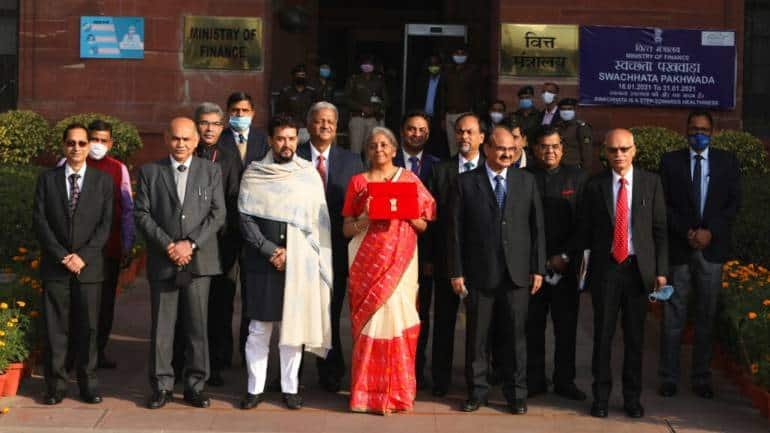Budget 2023 | What the market wants to hear from finance minister on Budget day

Finance Minister Nirmala Sitharaman from last year’s budget presentation day. (Centre).
As we near the end of 2022, the buzz around the 2023-24 Union Budget is getting stronger.
Set to be presented by Finance Minister Nirmala Sitharaman on February 1, it will be the last full one before the country votes in the 2024 general elections. As such, it is expected that Sitharaman will avert big-bang announcements and instead focus on boosting growth, sticking to the fiscal deficit target, and announce no additional taxes, especially on capital market activities.
“This year, the focus will have to be on growth, growth and growth,” said Anitha Rangan, an economist with financial services firm Equirus Capital. “This being the second full-year budget after the pandemic, and with the scars of the episode now more or less covered up, the expectation is that the finance minister will now align the budget to ensure all the cylinders of economy fire in tandem.”
During the pandemic, the government took a more reformist approach to support the economy instead of spending its way out of trouble like some other countries, given its difficult fiscal situation that prevailed even before COVID-19 hit.
The expectation now is that even a year before the general election, the government will stick to this prudent approach while batting for growth, especially as private investments are still lagging.
Capex push
For 2022-23, the Centre had set a record capex target of Rs 7.5 lakh crore, up 35 percent from the budget estimate for 2021-22. And it is on track to meet this figure, with the latest data showing that it had spent Rs 4.09 lakh crore or 55 percent of the target in the first seven months of the financial year.
Such is the government’s emphasis on capex that Sitharaman, in September, demanded to know from the private sector what was stopping them from investing.
The importance of reviving the private investment cycle cannot be overstated.
“Indian corporate sector has not invested for almost a decade and with capacity utilisation improving and profitability metrics looking good, they may consider investing in fresh capex for the next cycle,” Kaushik Das, chief India economist at Deutsche Bank, said in a note in October. But most corporates are still in wait and watch mode.
“Private sector investment is 75 percent of total investment; so even if private corporate sector decides to increase their capex spending somewhat over the next few years, this will be a good support for incremental growth and more importantly result in good quality growth,” Das added.
While the government has maintained that it intends to keep the pedal to the metal when it comes to capex in 2023-24, there is some signalling that the rise in public investments could be less than what it has been in recent years. Just last week, Chief Economic Adviser V Anantha Nageswaran said that at some point in time, the private sector would have to be given the space to become the “primary engine” of capital formation in the economy.
“It may not be necessary or may not be healthy for the public sector to keep expanding the capital investment at the same pace,” the government’s top economist said.
That being said, markets and industry continue to expect a sustained momentum in major government capex to push growth, with a focus across infrastructure segments, including water, transport, power and the social sector.
Government finances
If public investment will remain one of the key growth trigger for next year, it will have to go hand in hand with fiscal consolidation.
The pandemic years have seen the government’s fiscal deficit and stock of debt balloon. Annual deficit roadmaps were disbanded and a medium-term target of 4.5 percent of GDP by 2025-26 was announced even before the pandemic struck. Now, with the debilitating effects of lockdowns and the virus firmly behind, and tax collections handsomely beating budget estimates, markets expect the Centre to make marked progress in improving its finances. Not only does the market expect the fiscal deficit target of 6.4 percent of GDP for the current year to be met, the expectation is that the finance minister should gun for a budget estimate of lower than 6 percent for next fiscal.
Along with its finances, Rangan of Equirus says that what will help accelerate growth is for the Centre to aid state governments in alleviating some fiscal pressures.
“The government must contribute to state capex as well through allocation under capital expenditure to sustain growth. It will be good idea for the Centre to accelerate merit-based or project-based funding, and discourage states from resorting to inordinate market borrowing,” Rangan said.
The Centre’s Rs 7.5-lakh-crore capex target for 2022-23 includes a Rs 1-lakh-crore interest-free loan to states with a maturity of 50 years. This capex-only loan has been welcomed by states, with Sitharaman saying that states had shown great capacity to utilise these funds.
Money for capex apart, what has also helped is that the Centre has looked to push money to states earlier in the financial year. Tax devolution from the Centre to states is paid in 14 equal instalments every year, with two months seeing double instalments. While in earlier years these ‘double-instalment’ months came towards the end of the financial year, the Centre has brought them forward to aid states in their developmental expenditure. This year, both the double instalment months were completed by November itself—thanks, of course, to robust tax collections.
Markets and taxes
What the markets don’t want are unpleasant surprises on the tax front, especially as there are a host of other things for investors to worry about.
“Right from the geopolitical situation to inflation and interest rates, there are enough uncertainties on the horizon. The one thing markets would expect from the government is certainty in policy and no unnecessary changes to the tax regime,” said Raj Vyas, portfolio manager, Teji Mandi, a SEBI-registered advisory firm.
If anything, markets would like to see some sops come through in the budget that could give a boost to capital market flows. Financial savings have been growing in the past couple of years with strong flows reported into systematic investment plans and higher retail participation in the markets, which has helped stem the impact of foreign investors’ selling in equities this year.
According to Vivek Goel, joint MD, Tailwind Financial Services, “Incentives in terms of 80C deductions for retirement plans in mutual funds or simplifying tax structures or certain exemptions on short-term capital gains tax/long-term capital gains tax would be on the wish-list for markets.”
Investors will also love to see a reduction in the effective personal income tax rate, bringing it closer to the 25 percent effective corporate tax rate.
A partner at a top tax consulting firm who did not wish to be identified expects changes in the income tax slab rates in the upcoming budget, especially for those in the highest bracket. He suggested that the highest tax rate of 30 percent should be reduced to 25 percent and also the threshold for the highest tax rate should be revised upward from the present limit of Rs 10 lakh to Rs 20 lakh. This will not only give relief in income tax but will also provide more purchasing power to taxpayers, which will help support demand in the economy.
A new, but voluntary, income tax regime has already been announced (in FY20-21). While this regime has lower tax rates, it is devoid of exemptions and deductions.
According to Bibek Debroy, chairman of the Economic Advisory Council to the Prime Minister, it is crucial that India moves to an exemption-less income tax regime.
“Every year, the budget papers have a statement known as revenue forgone. Depending on the year, it amounts to 5-5.5 percent of GDP. So the moot question is, should those exemptions at all be there?” Debroy had said last month.
“In my view, and this is not an official view, this (voluntary exemption-less tax regime) is like jumping a ditch. You cannot jump a little bit of the ditch and hope to jump the rest of the ditch,” the economist had added.
One must wait until February 1 to see whether the ditch is bridged by the 2023-24 budget and what menu the finance minister will serve to the country.










